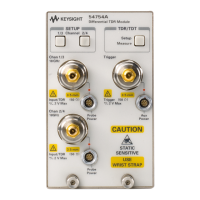Transmission Line Theory Applied to Digital Systems
Signal Propagation Delay for Microstrip and Strip Lines with Distributed or Lumped Loads
11-16
For a 50 Ω strip line on a glass epoxy board with a 15 mil spacing between the
strip line and ground plane, a 12 mil width would be required, and the strip line
would exhibit a capacitance of 41 pF/ft. The modified propagation delay for
such a strip line would be:
Notice that the propagation delay for the strip line and the microstrip line
change by approximately the same factor when the separation between the line
and ground plane, and the characteristic impedance are the same. However,
the line width of the strip line is less (by a factor of 2) than the microstrip line
for the same characteristic impedance.
It should be noted that to obtain the minimum change and lowest propagation
delay as a function of gate loading, the lowest characteristic impedance line
should be used. This will result in the largest intrinsic line capacitance. With
MECL 10K/10KH the lowest impedance that can be used is about 35 Ω
(V
TT
= - 2.0 V and R
TT
= 35 Ω).
According to theory, when an open line (stub) is driven by a pulse, the resultant
undershoot and ringing are held to about 15 percent of the logic swing if the
two way delay of the line is less than the risetime of the pulse. The maximum
line length, l
max
may be calculated using the equality:
where t
r
is the risetime of the pulse in nanoseconds, and t’
pd
is the modified
propagation delay in nanoseconds/inch from equation 11.
A quadratic equation for maximum line length for G-10 fiber glass epoxy
microstrip conductors may be written in terms of C
D
, C
o
, and t
r
as
(12)
where C
D
is the total gate capacitance.
t
′
pd
2.26 ns/ft 1
20
41
------+2.75 ns/ft==
l
max
t
r
2t
′
pd
------------
(inches)=
l
2
max
C
D
C
o
-------
l
max
11.1t
2
r
–+ 0 (for microstrip lines)=

